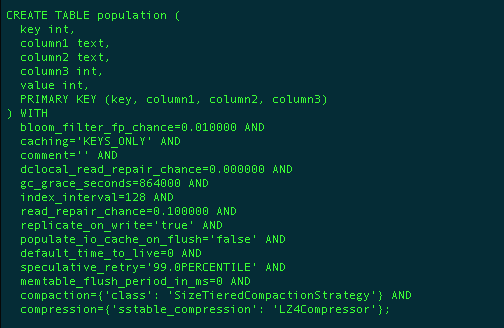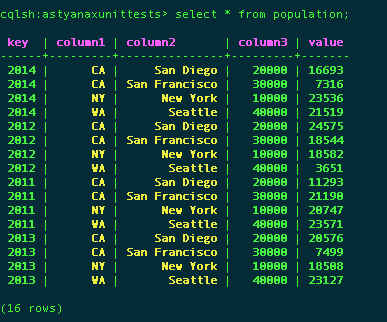-
Notifications
You must be signed in to change notification settings - Fork 354
Java driver composite columns
Consider the following hypothetical example. Here is a java pojo as a representation of a composite column.
public static class Population {
@Component(ordinal=0) String state;
@Component(ordinal=1) String city;
@Component(ordinal=2) Integer zipcode;
public Population() {
}
public Population(String state, String city, Integer zipcode) {
this.state = state;
this.city = city;
this.zipcode = zipcode;
}
public String toString() {
return "Population [" + state + ", " + city + ", " + zipcode + "]";
}
@Override
public int hashCode() {
final int prime = 31;
int result = 1;
result = prime * result + ((state == null) ? 0 : state.hashCode());
result = prime * result + ((city == null) ? 0 : city.hashCode());
result = prime * result + ((zipcode == null) ? 0 : zipcode.hashCode());
return result;
}
@Override
public boolean equals(Object obj) {
if (this == obj) return true;
if (obj == null)return false;
if (getClass() != obj.getClass()) return false;
Population other = (Population) obj;
boolean equal = true;
equal &= (state != null) ? (state.equals(other.state)) : other.state == null;
equal &= (city != null) ? (city.equals(other.city)) : other.city == null;
equal &= (zipcode != null) ? (zipcode.equals(other.zipcode)) : other.zipcode == null;
return equal;
}
public Population clone() {
return new Population(state, city, zipcode);
}
} Say that we want to tabulate the population for various cities for various years. Consider the year as the row key. And each composite column is the city, and the column name is it's population for that year.
Consider this schema

Note here that key is the row key. Column1, Column2 and Column3 are the key components of the composite column that map directly to the components of the java bean with the same order. Value is the population for that year and that city.
Consider these rows for the years 2011 - 2014

Here are the example queries to create this table, insert this data and then query this data
private AnnotatedCompositeSerializer<Population> compSerializer =
new AnnotatedCompositeSerializer<Population>(Population.class);
private ColumnFamily<Integer, Population> CF_POPULATION =
new ColumnFamily<Integer, Population>("population",
IntegerSerializer.get(),
compSerializer,
IntegerSerializer.get());
private Population NewYork = new Population("NY", "New York", 10000);
private Population SanDiego = new Population("CA", "San Diego", 20000);
private Population SanFrancisco = new Population("CA", "San Francisco", 30000);
private Population Seattle = new Population("WA", "Seattle", 40000);keyspace.createColumnFamily(CF_POPULATION, null);MutationBatch m = keyspace.prepareMutationBatch();
Random random = new Random();
for (int year = 2011; year <= 2014; year++) {
m.withRow(CF_POPULATION, year)
.putColumn(NewYork.clone(), random.nextInt(25000))
.putColumn(SanDiego.clone(), random.nextInt(25000))
.putColumn(SanFrancisco.clone(), random.nextInt(25000))
.putColumn(Seattle.clone(), random.nextInt(25000));
}
m.execute();MutationBatch m = keyspace.prepareMutationBatch();
for (int year = 2001; year <= 2014; year ++) {
m.withRow(CF_POPULATION, year).delete();
}
m.execute();for (int year = 2001; year <= 2014; year++) {
ColumnList<Population> result = keyspace.prepareQuery(CF_POPULATION)
.getRow(year)
.execute().getResult();
for (Column<Population> p : result) {
System.out.println(p.getName().toString() + " = " + p.getIntegerValue());
}for (int year = 2001; year <= 2014; year++) {
Column<Population> result = keyspace.prepareQuery(CF_POPULATION)
.getRow(year)
.getColumn(SanFrancisco.clone())
.execute().getResult();int year = 2011;
// ALL Cities in CA
ColumnList<Population> result =
keyspace.prepareQuery(CF_POPULATION)
.getRow(year)
.withColumnRange(compSerializer.buildRange()
.withPrefix("CA")
.build())
.execute().getResult();
// ALL Cities in CA starting from San Diego
result = keyspace.prepareQuery(CF_POPULATION)
.getRow(year)
.withColumnRange(compSerializer.buildRange()
.withPrefix("CA")
.greaterThan("San Diego")
.build())
.execute().getResult();
// WA, Seattle with zip starting from 40000
result = keyspace.prepareQuery(CF_POPULATION)
.getRow(year)
.withColumnRange(compSerializer.buildRange()
.withPrefix("WA")
.withPrefix("Seattle")
.withPrefix(40000)
.build())
.execute().getResult();Rows<Integer, Population> result = keyspace.prepareQuery(CF_POPULATION)
.getKeySlice(2011, 2012, 2013, 2014)
.execute().getResult();Rows<Integer, Population>
result = keyspace.prepareQuery(CF_POPULATION)
.getKeySlice(2011, 2012, 2013, 2014)
.withColumnRange(compSerializer.buildRange()
.withPrefix("CA")
.build())
.execute().getResult();
result = keyspace.prepareQuery(CF_POPULATION)
.getKeySlice(2011, 2012, 2013, 2014)
.withColumnRange(compSerializer.buildRange()
.withPrefix("CA")
.greaterThan("San Diego")
.build())
.execute().getResult();
result = keyspace.prepareQuery(CF_POPULATION)
.getKeySlice(2011, 2012, 2013, 2014)
.withColumnRange(compSerializer.buildRange()
.withPrefix("WA")
.withPrefix("Seattle")
.withPrefix(40000)
.build())
.execute().getResult();A Netflix Original Production
Tech Blog | Twitter @NetflixOSS | Jobs
- Getting-Started
- Configuration
- Features
- Monitoring
- Thread Safety
- Timeouts
- Recipes
- Examples
- Javadoc
- Utilities
- Cassandra-Compatibility
- FAQ
- End-to-End Examples
- Astyanax Integration with Java Driver